Sheldon Brown's
Bicycle Glossary Da - Do

|
![]()
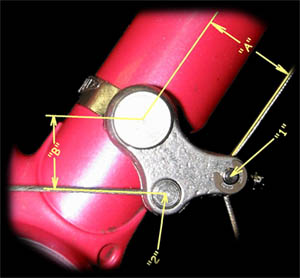 Demultiplier (Démultiplicateur in French)
Demultiplier (Démultiplicateur in French) The cable from the shifter connects to point "1", acting on radius "A".
The cable to the derailer connects to point "2" acting on radius "B".
The cable travel at the upper section is increased by the ratio A/B.
Cable tension on the segment between the shifter and the demultiplier is reduced by the ratio B/A.
The Jtek ShiftMate is a similar device, used to match indexing when shift controls are mismatched with a different derailer.
Since the popularization of direct-pull cantilevers, such as Shimano's V-Brake, several companies have introduced new versions of the demultiplier, for example the Quality Bicycle Products Travel Agent ®, to permit conventional levers to work with these brakes.
Mark Bulgier Photo https://www.flickr.com/photos/61312162@N02/
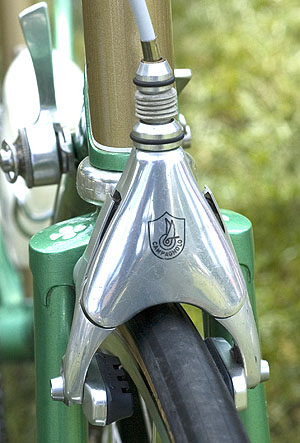 Delta Brakes (Campagnolo)
Delta Brakes (Campagnolo) A parallel business uses department stores and discount stores for distribution. They concentrate on a much lower price segment, and sell a drastically inferior product. The bicycles sold in department stores are made as cheaply as possible, from the poorest materials available. The average department-store bicycle is ridden about 75 miles in its lifespan from showroom floor to landfill. The manufacturers know this, and build them accordingly. Department-store bicycles are most commonly sold in a partially disassembled and un-adjusted condition. ******
![]()
![]()
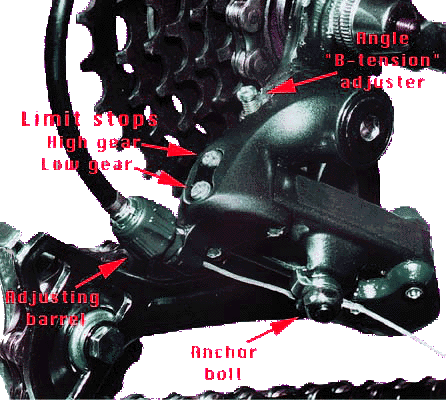
A typical derailer consists of a parallelogram which moves a cage. In the case of a rear derailer, the cage has two chain pulleys, a jockey pulley and a tension pulley. Different derailers have different capacities to handle different gear ranges. Also commonly spelled in the French style "Derailleur."
You can calculate gain ratios., gear inches or meters development with my Online Gear Calculator or with your slide rule
Dia Compe first made a major impression on the bicycle industry in the late '60's, by inventing extension levers for drop-bar brakes. At that time, Weinmann was the leading brake manufacturer. Dia Compe's extension levers were so popular that Weinmann entered into a licensing agreement with Dia Compe, allowing Dia Compe to copy Weinmann's brakes in return for letting Weinmann copy Dia Compe's extensions.
More recently, Dia Compe has revolutionized the design of headsets, with its "AheadSet" threadless headsets.
This is not to say that the diamond frame is the end-all and be-all of bicycle design. Monocoque construction with suitable materials has real merit, and the design of bicycles with rear suspension is at a stage where many different designs appear viable.
![]()
![]()
| Size | Application | System |
|---|---|---|
| 6 mm | Brake center bolts | |
| 25.0 x 1.0 mm | Steering columns | French |
| 1" x 24 tpi | Steering columns | British, Italian, I.S.O. |
| 1 1/8" (28.6 mm) x 26 tpi | Steering columns | oversized |
| 1 1/4"(31.8 mm) x 26 tpi | Steering columns | oversized |
The corresponding bolt-like tool for cutting internal threads is called a tap.
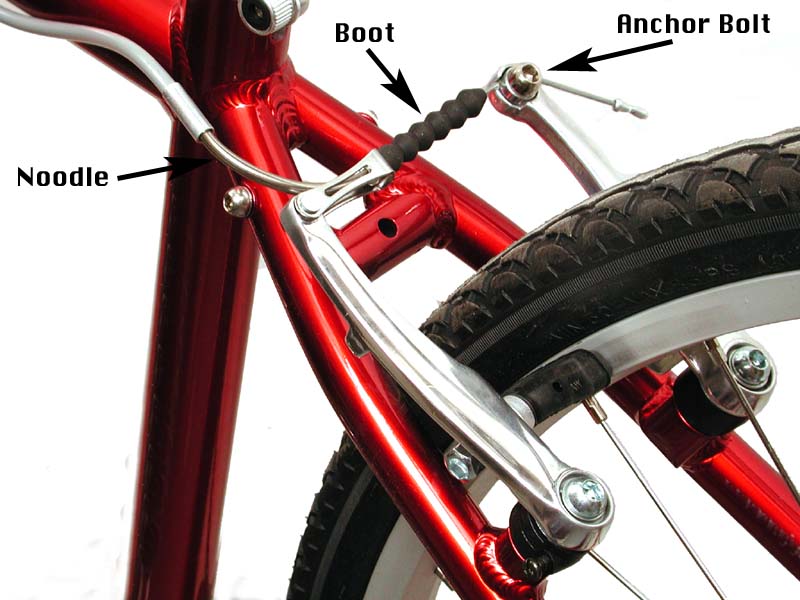 Direct-Pull cantilever
Direct-Pull cantilever This type of cantilever does not use a separate transverse cable. It has two tall arms, one of which has a housing stop and the other the anchor bolt. The exposed part of the cable runs horizontally from one arm to the other.
Direct-pull cantilevers have more mechanical advantage than other brakes, so they require special hand levers with less-than-average mechanical advantage to keep the overall mechanical advantage in a useful range.
Wheels should be built so that the rim is centered exactly between the axle ends on the hub. In rear wheels, the spokes attach to flanges which are not symmetrical about the centerline...the right flange is usually closer to the centerline than the left flange, to make room for the sprocket(s).
When rear wheels are built properly, the spokes on the right side are made tighter than those on the left side, pulling the rim to the right, so that it is centered with respect to the axle (and to the frame.) Viewed edgewise, a rear wheel built this way resembles a dish, or bowl, since the left spokes form a broad cone, while the right spokes are more nearly flat.
By extension, the term "dish" is used as a general synonym for accurate centering, even in the case of symmetrical wheels.
See also my Wheelbuilding article.

![]()
![]()
Some early disc brakes had a reliability problem, in that outer part of the disc could break away from the part that attached to the hub, causing complete failure with no warning whatever. When the rider would squeeze the brake lever, it would feel solid, as the caliper was gripping the disc securely...unfortunately, it would do nothing to stop the bicycle!
Disc brakes are becoming increasingly common, partly because they work in wet conditions when rim brakes don't, partly because they don't cause wear to rims, and partly because of fashion.
See our article about disc brakes.
There have been concerns about the safety of front disc brakes in conjunction with quick-release skewers. See James Annan's article on this topic.
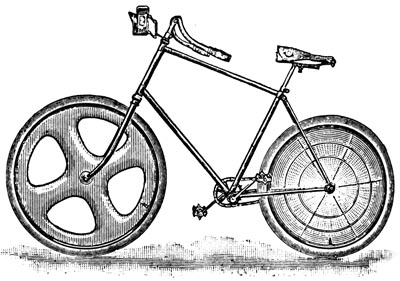
The illustration is from Archibald Sharp's Bicycles and Tricycles, originally published in 1896, republished by the M.I.T. Press in 1977.
The front wheel has cutouts to reduce steering problems that result from crosswinds when disc wheels are used on the front.
![]()
![]()
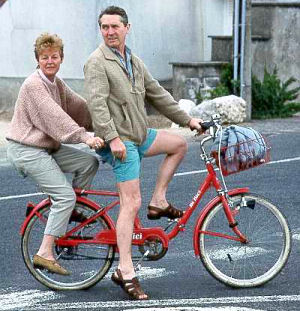 Donkey-Back
Donkey-Back It requires a very special rear hub with an axle within an axle. There is a sync chain running from the donkey back's cranks forward to the penultimate stoker's crankset.
Donkey backs were used primarily around the turn of the century as pacing vehicles (usually quads) for track races (a task later taken over by special motorcycles, such as the Derny). The donkey-back design placed the rear stoker back over the wheel, to give the racer on the solo the best possible draft. Some donkey-backs have been sold as utility tandems.
The most common application for double-sided hubs is for fixed-gear bicycles. Many fixed-gear fans have a fixed sprocket on one side, and a freewheel on the other, using one or the other as conditions change. This is discussed at more length in my article on Fixed Gear Road Bicycles.
![]()
![]()
![]()
Last Updated: by Harriet Fell